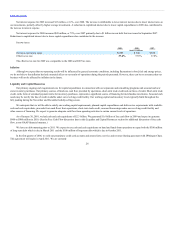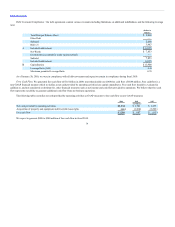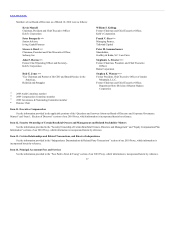Kohl's 2009 Annual Report Download - page 27
Download and view the complete annual report
Please find page 27 of the 2009 Kohl's annual report below. You can navigate through the pages in the report by either clicking on the pages listed below, or by using the keyword search tool below to find specific information within the annual report.
Table of Contents
exploring various options related to the Kohl’s credit card, including entering into a new agreement with an alternative partner. We expect to reach a decision by
Fall 2010. This timing could be impacted by the timing of the issuance of the final CARD Act regulation. We currently believe that we will be able to negotiate a
new contract with a financial institution that would be similar in nature to our existing arrangement. If, however, we are unable to do so, we may repurchase
the receivables from JPMorgan Chase. We would expect to use a combination of cash on hand, funds from operations and/or proceeds from the issuance of
debt and/or stock to fund the repurchase of the receivables. If we do not repurchase the receivables, we will consider other potential uses for our cash
equivalent balances after finalizing a new agreement.
Operating activities $1,698 $1,205
Investing activities (963) (1,596)
Financing activities (273) 325
Operating activities.
Cash provided by operations increased 32% in 2009 to $2.2 billion. The most significant source of operating cash flow for 2009 was a $258 million
increase in cash flows from accounts payable activities. Short-term trade credit, in the form of extended payment terms for inventory purchases, represents a
significant source of financing for merchandise inventories.
At January 30, 2010, total merchandise inventories increased $124 million, or 4%, from year-end 2008. On a dollars per store basis, merchandise
inventories at January 30, 2010 decreased 0.9% from year-end 2008. Clearance inventory units per store are down approximately 14%. These reductions are the
result of inventory management initiatives, including our conservative sales and receipt planning and lower clearance levels.
Accounts payable at January 30, 2010 increased $307 million from year-end 2008. Accounts payable as a percent of inventory was 40.6% at
January 30, 2010, compared to 31.5% at year-end 2008. Our cycle time process improvements on fashion categories and a focus on replenishment of basics
have allowed us to consistently receive inventory based on sales volume and to improve our inventory management by merchandise area and store location.
With the cooperation of our vendor partners, we have been able to reduce our lead time by accelerating inventory receipts to support our recent sales growth.
Extended payment terms have also contributed to an increase in our accounts payable balance. We provided our vendors with financing, at a rate better than
market, in exchange for extended payment terms.
Despite the decrease in net income in 2008, cash provided by operations increased 41% over 2007 to $1.7 billion in 2008, primarily due to a $335
million reduction in cash used for inventory purchases. Compared to year-end 2007, total merchandise inventories at January 31, 2009 decreased 2% and
inventory per store decreased 9.3%. Clearance inventory units per store were down approximately four times more than total inventory per store. These
reductions were the result of our conservative sales and receipt planning. Accounts payable at January 31, 2009 increased $45 million from year-end 2007.
Accounts payable as a percent of inventory was 31.5% at January 31, 2009, compared to 29.3% at year-end 2007, primarily due to strong inventory
management, our cycle time reduction initiatives and improved vendor financing management.
Investing activities.
Net cash used in investing activities decreased $323 million to $640 million in 2009, primarily due to a decrease in capital expenditures.
27
























